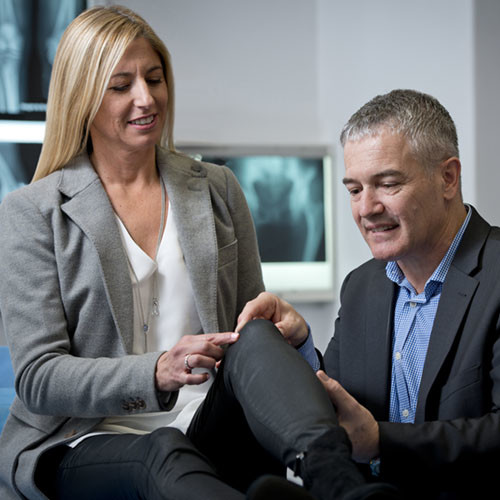
Patellofemoral pain is most common in young adults, affecting an estimated 20% of the population. Its symptoms often start gradually, but may appear suddenly following trauma to the knee.
Signs to be aware of include:
· Localised pain originating from behind the kneecap
· Vague, aching pain around the kneecap
· Cracking and/or popping sounds when standing or climbing stairs (without pain)
· Feelings of weakness or instability in the knee
Pain presenting from patellofemoral pain syndrome is generally of aching type, but may feel sharp on occasion. It may be aggravated when the knee assumes a bent position, such as while climbing stairs, cycling, squatting, or kneeling. It may also present following a long period of sitting.
The presence of these symptoms does not necessarily indicate patellofemoral pain syndrome. If you have any concerns, please speak with your GP for further advice.
Patellofemoral pain develops more often in women than in men. This may be due to the width of the pelvis, which increases the angle at which the bones in the knee joint meet each other.
As Patellofemoral pain syndrome can be described as an overuse injury, athletes and manual labourers are more likely to develop the condition. It may also present in people who sit with a bent knee for extended periods of time, such as office workers – sometimes referred to as ‘Moviegoer’s knee’, as many sufferers find it presents after sitting for long periods while watching a movie.
As the name may suggest, patella-femoral pain results from irritation between the patella (kneecap) and femur (thigh bone). This may result from repetitive bending motions, such as those made when climbing stairs, running, jumping, kneeling, or doing squatting exercises. It may also result from an abnormal or increased load on the knee joint (such as excessive weight gain) or may present as a normal ‘developmental pain’.
The articular cartilage behind the knee cap can soften during the teenage growing years and cause pain. Happily, the cartilage seems to toughen up with time (sometimes several years) and symptoms naturally reduce.
Although the exact cause of patellofemoral pain remains unclear, overuse and trauma are believed to be contributors. Patellofemoral pain may also result from misalignment of the muscles surrounding the hip and kneecap, which can impact running and jumping technique.
Prompt diagnosis of patellofemoral pain ensures the best possible outcomes. Patellofemoral pain is most often diagnosed with a history and physical examination conducted by a GP or specialist. X-rays may be ordered to rule out any underlying bone damage or accompanying injury. An MRI may be ordered to assess the ligaments, soft tissues, and alignment of the knee to exclude other causes.
Most cases of patellofemoral pain improve with non-surgical treatment. The aim of treatment is to reduce pain and restore previous levels of motion and strength.
Treatment generally involves reducing the load on the affected knee until the injury heals, such as by reducing activity. This may be supplemented with over-the-counter nonsteroidal anti-inflammatory medication (such as ibuprofen). Physical therapy may be recommended to stretch up the quadriceps muscle, strengthen the muscles around the knee and avoiding aggravating activities. Taping or bracing of the kneecap may be used to take stress off the lower leg during activity.
Surgical treatment for patellofemoral pain is rarely necessary.
Explore treatment options
Knee Treatments
















